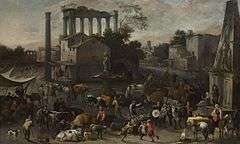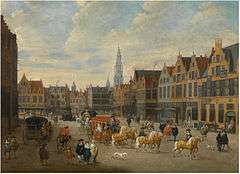Erasmus de Bie
Erasmus de Bie (1629 in Antwerp – 1675 in Antwerp) was a Flemish painter known for his city views and landscapes.
Life
Very little is known about the life of Erasmus de Bie. He was born in Antwerp as the son of the painter Frans de Bie the Elder. He was baptised on 20 December 1629 in the St. Walburga church in Antwerp.[1]

He became a pupil of David Ryckaert III in 1641 and was admitted as a master to the Antwerp Guild of St. Luke in 1645-1646.[2][3][4]
He married Catharina Douglas, called de Schot (the Scot), and was the father of Frans and Jan Baptist de Bie, who both became painters.[1] Jan Baptist emigrated to Vienna where he remained active.[5][6]
Erasmus de Bie had pupils in 1660 and in 1666 of whom one was his son Frans.[5]
Work
He is known for his architectural paintings, in particular city scenes, genre scenes and landscapes in an Italianate style.[5][7] He is also mentioned as the creator of religious scenes and compositions with animals.[1] His surviving signatures are in capital letters: ED (in ligature) BIE.[5]

His main specialty was the composition of animated landscapes, in particular of city squares. He collaborated with other artists in Antwerp for whom he painted the staffage. This is documented in the papers of the Antwerp art dealers Forchondt, which mention two anonymous church interiors with figures painted by de Bie.[5]
He produced Italianate landscapes set among Roman buildings and populated with many figures and animals reminiscent of the style of the group of genre painters active in Rome known as the Bamboccianti. An example is the Campo Vaccino in the collection of the Victoria Art Gallery in Bath, Somerset.[8] He is also mentioned as the author of at least one winterscape and two seascapes.[5]
His composition The Ommegang in Antwerp was reinterpreted by various Flemish artists including Alexander van Bredael.[9] It may itself have been inspired by Pieter van Aelst's painting with the same theme.[10]
References
- 1 2 3 Frans Jozef Peter Van den Branden, Geschiedenis der Antwerpsche schilderschool, Antwerpen, 1883, p. 1028-1029 (Dutch)
- ↑ B. Van Haute, 'David III Ryckaert: A Seventeenth-Century Flemish Peasant Painter of Peasant Scenes', Brepols, 1999
- ↑ The Meir by Erasmus de Bie at Barok in Vlaanderen
- ↑ Ph. Rombouts en Th. Van Lerius, 'De Liggeren en andere Historische Archieven der Antwerpsche Sint Lucasgilde, onder Zinkspreuk: "Wy Jonsten Versaemt"', Julius de Koninck, 1871, p. 373.
- 1 2 3 4 5 6 Erasmus de Bie at the Netherlands Institute for Art History (Dutch)
- ↑ Jean Baptiste de Bie at the Netherlands Institute for Art History (Dutch)
- ↑ Arthur Edwin Bye, 'History of the Bye family and some allied families', Correll Print. Co., 1956
- ↑ Campo Vaccino in the collection of the Victoria Art Gallery in Bath
- ↑ Une procession animée at Musėe de Flandre (French)
- ↑ Peter van Aelst, The Ommegang on the Meir in Antwerp, at Jean Moust
External links
![]() Media related to Erasmus de Bie at Wikimedia Commons
Media related to Erasmus de Bie at Wikimedia Commons